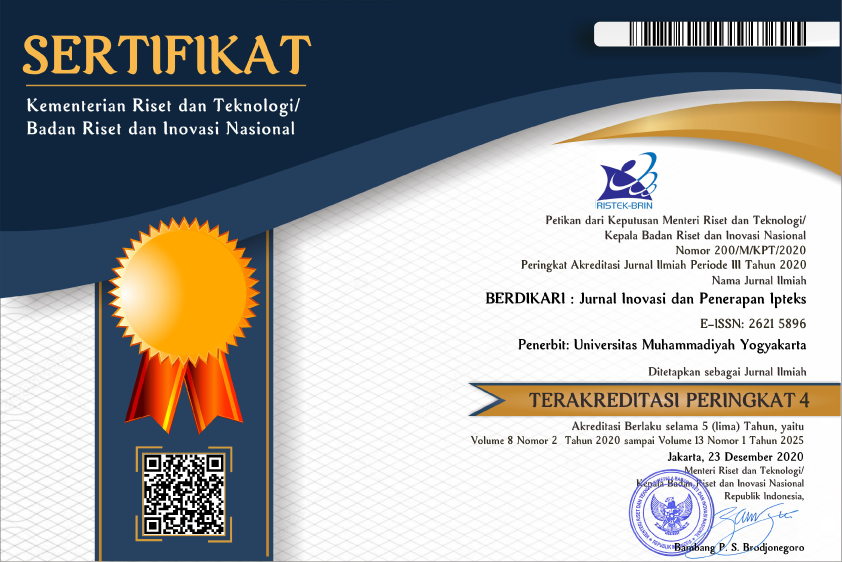Implementation of the Smart and Green Building Concept in the UMY Student Dormitory Building
DOI:
https://doi.org/10.18196/berdikari.v13i2.28064Keywords:
Campus Sustainability, Energy Efficiency, Green Building, Smart Building, Student DormitoryAbstract
The design of student housing in the modern era is not only required to provide functional comfort but also to address the challenges of energy efficiency and environmental sustainability. Universitas Muhammadiyah Yogyakarta (UMY) responds to these needs through the development of a Student Dormitory that adopts the principles of smart and green building. The purpose of this community engagement program is to evaluate the implementation of intelligent and environmentally friendly building concepts from technical, functional, and operational economic perspectives. This program employs a case study method with a descriptive qualitative approach, based on the analysis of building technical documents and a review of relevant national and international scientific literature. The findings show that the integration of digital access control systems (smart access), energy-efficient VRV (Variable Refrigerant Volume) cooling, harmonic filters, solar water heaters, and the use of Panasap Blue Glass has significantly contributed to reducing energy consumption by up to 40%. In addition to enhancing residents’ comfort and security, these technologies also demonstrate potential investment payback within 5 to 7 years. The implications extend beyond cost and operational efficiency, contributing directly to the achievement of the Sustainable Development Goals (SDGs). Furthermore, this program is grounded on the principle of sustainability, emphasizing the long-term utilization of eco-friendly technologies, the principle of benefit, ensuring tangible advantages for students, the university, and the wider community through improved quality of life and reduced carbon footprint; and the principle of economic viability, guaranteeing operational cost efficiency and financial sustainability of the project. The strategic objectives of this community engagement initiative are (1) to establish UMY’s Student Dormitory as a model of environmentally conscious student housing in tropical regions, (2) to promote knowledge and technology transfer on smart and green buildings to other universities, (3) to strengthen UMY’s reputation as a modern campus aligned with the SDGs agenda, and (4) to create an energy-efficient housing ecosystem that contributes to long-term cost savings and improved residents’ well-being. In conclusion, the study indicates that UMY’s student housing model, based on smart and green building principles, is feasible to adopt as a reference for dormitory development in other higher education institutions, particularly in tropical areas
References
Ali, H., et al. (2020). Sustainable Dormitory Design for Higher Education Institutions. J. Building Performance.
Zhang, J., et al. (2022). Innovative Dormitory System Based on IoT Technology. Sustainability.
Ahmed, S., et al. (2022). Daylighting and Glazing Materials Impact on Energy Saving. Journal of Cleaner Production.
Zhao, X., et al. (2020). Energy-Efficient HVAC in High-Rise Buildings. Renewable Energy.
Lin, H., & Hong, T. (2019). Thermal Comfort and VRV Systems. Energy and Buildings.
Tang, R., et al. (2021). Security Access Systems for Smart Campuses. Sensors.
Kandil, A., et al. (2022). Building Automation Systems in University Buildings. Journal of Automation in Construction.
Yusof, M. B., et al. (2020). Solar Water Heating Systems in Tropical Dormitories. Energy Reports.
Nguyen, T., & Zhang, R. (2023). Heat Pump Integration in Multi-story Buildings. Journal of Building Engineering.
Abidin, N. Z., & Pasquire, C. (2020). Cost-Benefit Analysis of Green Buildings in Southeast Asia. Green Design Journal.
Islam, M. R., et al. (2021). Economic Performance of VRF Systems in Hostels. Energy Economics.
Park, J., et al. (2018). Structural Design for Seismic-Resilient Dormitories. Journal of Structural Engineering.
Lee, K., et al. (2019). Smart Dormitory at NUS: Implementation and Evaluation. IEEE Access.
Prasetyo, A., et al. (2022). Asrama Hijau UGM: Studi Kasus Implementasi Green Building di Indonesia. Jurnal Arsitektur Nusantara.
GBCI. (2020). Green Building Rating for Dormitories. Green Building Council Indonesia.
ISO 50001:2018. Energy Management Systems – Guidelines. ISO.
ASHRAE. (2016). Fundamentals of HVAC Design for Dormitories. ASHRAE Handbook.
Pratama, H., et al. (2021). Sistem Cerdas untuk Asrama Mahasiswa. Jurnal Teknologi dan Rekayasa.
Handayani, T., et al. (2023). Analisis Efisiensi Energi pada Bangunan Asrama Mahasiswa. Jurnal Teknik Sipil Terapan.
UMY. (2025). Dokumen Teknis Student Dormitory. Universitas Muhammadiyah Yogyakarta.
Published
Issue
Section
License
Copyright (c) 2025 Sukamta Sukamta, Agus Jamal, Nafi Ananda Utama, Rudy Suryanto, Bagus Subandono, Gunawan Budiyanto, Arwan Suryanto

This work is licensed under a Creative Commons Attribution 4.0 International License.
Copyright
Authors retain copyright and grant BERDIKARI Jurnal Inovasi dan Penerapan IPTEK the right of first publication with the work simultaneously licensed under an Attribution 4.0 International (CC BY 4.0) that allows others to remix, adapt and build upon the work with an acknowledgment of the work's authorship and of the initial publication in BERDIKARI Jurnal Inovasi dan Penerapan IPTEK.
Authors are permitted to copy and redistribute the journal's published version of the work (e.g., post it to an institutional repository or publish it in a book), with an acknowledgment of its initial publication in BERDIKARI Jurnal Inovasi dan Penerapan IPTEK
License
Articles published in the BERDIKARI Jurnal Inovasi dan Penerapan IPTEK) are licensed under an Attribution 4.0 International (CC BY 4.0) license. You are free to:
- Share — copy and redistribute the material in any medium or format.
- Adapt — remix, transform, and build upon the material for any purpose, even commercially.
This license is acceptable for Free Cultural Works. The licensor cannot revoke these freedoms as long as you follow the license terms. Under the following terms:
- Attribution — You must give appropriate credit, provide a link to the license, and indicate if changes were made. You may do so in any reasonable manner, but not in any way that suggests the licensor endorses you or your use.
- No additional restrictions — You may not apply legal terms or technological measures that legally restrict others from doing anything the license permits.




